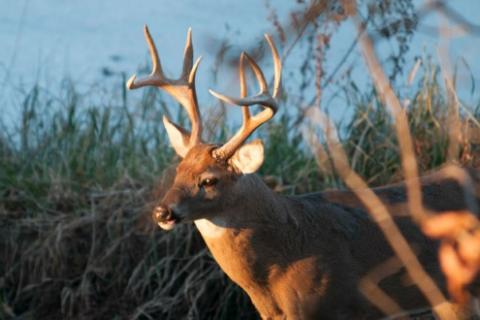
Streams and creeks allow bucks to quench their thirst while finding cooler temperatures and thick cover. This makes them terrific early season hotspots—ones that are neglected by many deer hunters.
Creeks act as natural funnels for buck travel which gives you the perfect opportunity to set up along them. Determining how deer are using the water source will allow you to place your stand accordingly.
1. Scouting for Deer Sign at the Watering Hole
You’ve located large tracks leading to the water on only one side of the stream. They may be where a pool backs up the creek or near a single strip of cover. Tread lightly— a dominant buck feels comfortable slipping in here for an afternoon drink before heading off to feed.
In this situation your buck isn’t bedding on the stream, but rather a short distance away. He may be on a knoll or finger of cover branching off the creek. The foliage allows him to feel comfortable moving in the daylight.
 Set up downwind of that location. Be extra cautious approaching this stand site as you’ll be close to his daytime hideout. Sneak in at first light if possible. Pack a lunch and get some rest the night before. An all-day sit is your best bet, and you don’t want your afternoon nap to coincide with the bruiser’s happy hour.
Set up downwind of that location. Be extra cautious approaching this stand site as you’ll be close to his daytime hideout. Sneak in at first light if possible. Pack a lunch and get some rest the night before. An all-day sit is your best bet, and you don’t want your afternoon nap to coincide with the bruiser’s happy hour.
2. You've a Deer Travel Lane - What Next?
You’ve found lightly outlined trails with large tracks paralleling the stream. They lead from a bedding area towards afternoon feed. This buck is using the water’s edge as a highway to fast-food.
Set up far enough from the bedding cover that you don’t spook him getting to your stand—100 yards or more if possible. Be sure to find a balance here, however, as the closer to the bedding area you can set up, the better your chances that the mature buck will show in daylight. You want to intercept him between his afternoon nap and evening meal.
The wind should be blowing from the feeding area towards the bedding cover for the buck to feel comfortable using this route. Place your stand cross and slightly downwind of the trail. You’ll be off to the side, with your scent blowing parallel to the buck and slightly away.
3. The Deer Crossing
You found a shallow riffle in the stream with large tracks on both sides. Rubs on trees near the creek confirm that a buck is using this spot to cross.
All deer—even the most cautious of bucks—will take the path of least resistance whenever possible. A crossing indicates that there is something on either side that makes it worth wetting a hoof.
These motivations typically come in the form of bedding and feeding areas—not to mention the does that frequent them. Locating a crossing will help you pinpoint where a big buck is hanging out and allow you to intercept him.
A crossing that remains shallow during periods of heavy rain can be a huge asset. Be sure to set up nearby when flooding occurs as the rising water levels could seal off other passages—funneling deer right to your stand.
Don’t neglect the creeks on your hunting property this season. A small stream could quench your thirst for a bruiser buck.
For even more info, check out this video on how to use a deer's stomach to your advantage.
- 23532 views

